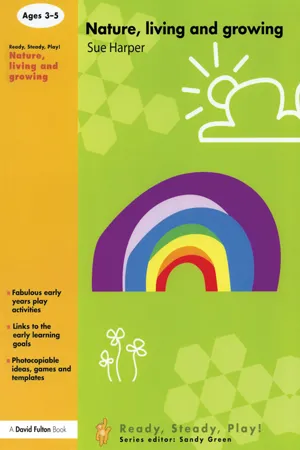
This is a test
- 88 pages
- English
- ePUB (mobile friendly)
- Available on iOS & Android
eBook - ePub
Nature, Living and Growing
Book details
Book preview
Table of contents
Citations
About This Book
Nature, Living and Growing focuses on outdoor play and how nature can contribute to a child's learning and development. Split into four sections, which focus on each of the four seasons – spring, summer, autumn and winter, this book:
-
- includes activities appropriate to each season
-
- offers ideas for 'wander walkabouts' to inspire and set the scene of what the season can offer in regard to play activities
-
- promotes knowledge of the environment and how to use natural resources effectively.
Frequently asked questions
At the moment all of our mobile-responsive ePub books are available to download via the app. Most of our PDFs are also available to download and we're working on making the final remaining ones downloadable now. Learn more here.
Both plans give you full access to the library and all of Perlego’s features. The only differences are the price and subscription period: With the annual plan you’ll save around 30% compared to 12 months on the monthly plan.
We are an online textbook subscription service, where you can get access to an entire online library for less than the price of a single book per month. With over 1 million books across 1000+ topics, we’ve got you covered! Learn more here.
Look out for the read-aloud symbol on your next book to see if you can listen to it. The read-aloud tool reads text aloud for you, highlighting the text as it is being read. You can pause it, speed it up and slow it down. Learn more here.
Yes, you can access Nature, Living and Growing by Harper Sue in PDF and/or ePUB format, as well as other popular books in Education & Education General. We have over one million books available in our catalogue for you to explore.
Information
Activities
The following pages contain twenty-four activities to enjoy throughout the year, divided into the four seasons. Each seasson has an introduction, and all the activities follow a standard format to ensure ease of planning and implementation:
- the resources needed
- the aim(s)/concept(s)
- the process
- group size
- health and safety
- vocabulary/discussion ideas
- extension ideas
- links to the Foundation Stage Curriculum.
Key to Foundation Stage Curriculum abbreviation
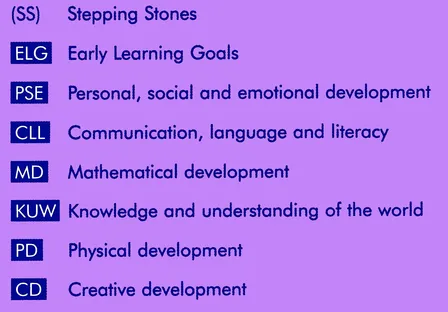
Introduction to autumn
For practitioners, encouraging children to enjoy their outdoor natural environment should be a central part of a routine, rather than an optional extra. Autumn is a great 'child friendly' season in which to put this into action.
On an autumn 'wonder walk', children's senses will be met with an array of beautiful colours, tastes, sights and sounds, and in this introduction are some ideas to take adults and children through this exciting season.
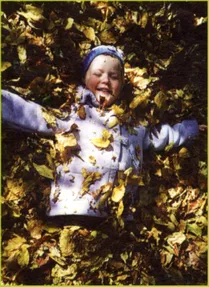
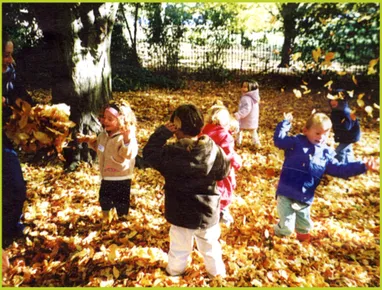
Autumn is the season when nature is preparing to 'shut down' for the winter, but before it does, it offers up all kinds of activities for us and our wildlife to explore.

- In autumn the days are shorter, nights are longer, colder and more windy. The sun rises later and sets earlier.
- The tops of the trees start to change colour, reds, yellows, browns and oranges. They make lovely rustling noises as they bend to and fro in the strong winds which roar through their leaves, making them fail to the ground - fun to run through and collect. Some trees, like the horse chestnut and oak, make seeds for next year - conkers and acorns can be collected.
- Plants and trees spread their seeds in different ways. Encourage the children to look for seeds that are light enough to be blown by the wind, such as maple and dandelion. Explain that nature is helping the seeds to survive and that when they land on the soil, and if they survive the winter, the first few warm days of spring will wake them up, and a new plant or tree will prepare to grow. Nature is clever.
- Animals such as hedgehogs, badgers and dormice also prepare for winter and hibernate. They collect as many berries, nuts, seeds and fruit as they can and store them somewhere safe to eat during the cold winter months.
- Some birds, like the swallow, gather to migrate to warmer countries look out for large flocks flying overhead.
- Some plants give us delicious berries to eat, like blackberries, fun to collect and eat raw or cooked. Birds and animals also love them.N.B. Not all berries are safe for us to eat.
- Autumn is traditionally considered to be harvest time. The fruits on our trees are ripe and ready for picking, like the apples, pears and damsons. Nuts from the hazel bush or tree can be collected and saved until they turn brown and are then ready for cracking open to eat. Pumpkins are ready to pick, to enjoy and to make lanterns with.
- Set up a seasonal table or display area where children can freely contribute with things they have collected or made and which can provide an ongoing focal area for autumn discussion.
Activities
- Nature collage
- Natural colour dyeing
- Leaf banners
- Bulb planting for a spring garden
- Life in the soil: making a wormery
- Pumpkin playtime
Worm facts
- They eat their own weight in organic matter every day.
- Worms often leave their back end in the burrow. If you touch them, they shoot back underground.
- Bristles on the worm's body grip in the soil, which sometimes makes it difficult for a bird to pull them out of the ground.
- A worm is both female and male. When they need to mate, they swap sperm to fertilise the eggs which they lay in the soil.
- Worms can live for several months or up to ten years.
- Some worms curl up and sleep when it is hot and dry in the summer.
- Moles store worms in an underground 'larder'. They bite off their heads to stop them escaping, but unless the mole eats it quickly, the worm can grow a new head and escape.
- Worms cannot live above ground. When dug up, they immediately burrow back into the soil.
Pumpkins
A pumpkin takes many months to grow. You can grow one either from seed or from a plant, and put it directly into the ground. When the plants have five leaves, pinch out the tips. This will make them bushy. They grow along the ground. Keep the fruits off the soil by laying them on straw or tiles (to avoid them being eaten by insects). Water the plant well throughout the summer. It will be ready in late autumn. Once picked, leave it to harden for two weeks before using.

Activity 1
Nature collage
Resources
- A selection from the following:
- Wood shavings
- Cereals such as oats
- Small or broken shells
- Sand
- Seeds and beans
- Herbs
- Leaves
- Feathers
- Bits of bark/tiny twigs/pine needles/cones
- Rounded pieces of sea glass
- Small pieces of raffia or hessian
- Strong card (different sizes and shapes if liked)
- PVA glue and brushes
- Pencils
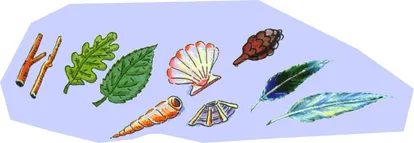
Aim/concept
To provide children with the opportunity to explore their environment and to consider what natural resources might be fun and interesting to use in creating a nature collage.
Process
In advance
- Discuss with the children ideas of natural resources that may be suitable for making a collage (select one or two as examples).
- Ask them to explore their environment both at home and within the setting to see what can be found.
- Provide card in various shapes and sizes.
- Display the selection of collected items, and explain to the children that they can choose their card and make a collage to their own design (they may wish to draw their idea first).
- Provide PVA glue.
- Encourage them to explore the different textures, talking about where they were found or where they came from.
- Supervise and support the children as they create their collages, admiring their work.
Vocabulary/discussion
- Name the different types of natural resources.
- Discuss the different textures and how they feel and smell.
- Talk about shape and size.
- Share stories as to where they found their particular resource.
- Did they have a favourite, which they preferred more than another? If so, why?
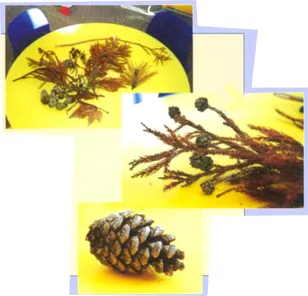
Group size
4-6
Links to Foundation Stage Curriculum
PSE Show increasing independence in selecting and carrying out activities (SS)
ELG Be confident to try new activities, initiate ideas and speak in a familiar group
CLL Use talk, actions and objects to recall and relive past exp...
Table of contents
- Cover Page
- Half Title page
- series
- Title Page
- Copyright Page
- Contents
- Acknowledgements
- Introduction
- Discussion resources
- Activities
- Photocopiable pages
- Reading suggestions